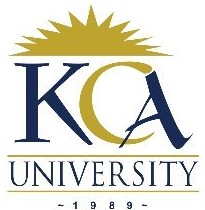
UNIVERSITY EXAMINATIONS: 2016/2017
EXAMINATION FOR THE DIPLOMA IN INFORMATION
TECHNOLOGY
DIT204 DISCRETE MATHEMATICS
DATE: AUGUST, 2017 TIME: 1 ½ HOURS
INSTRUCTIONS: Answer Question One & ANY OTHER TWO questions.
QUESTION ONE
a) Briefly explain your understanding of discrete mathematics as contrasted with other
branches of mathematics (4 Marks)
r “a” belongs to the set of the English alphabet vowels, V. Express that statement u
b) The lette sing an appropriate mathematical symbol (4 Marks)
c) A sample of 55 secondary school students was surveyed to determine some KNEC
registration statistics. Of those sampled, the registration numbers were as follows: 25,19
and 22 students registered for Geography, Chemistry and Biology respectively; 10
registered for Chemistry and Geography, 9 registered for Chemistry and Geography; 7
registered for Geography and Biology whereas 4 registered for all the three subjects.
I. Represent the above information on a Venn diagram (4 Marks)
II. From the Venn diagram in (i) above, determine (4 Marks)
i. The number of students that registered for only one of the
three subjects (4 Marks)
ii. The percentage of students that registered for none of the
three subjects (4 Marks)
QUESTION TWO
a) Define a proposition and state any three valid propositions (3 Marks)
b) Define with help of truth tables and proposition p and q:
i. A conjunction (3 Marks)
ii. A disjunction (3 Marks)
iii. Negative of proposition q (3 Marks)
c) With the help of a truth table, show that
a contradiction (4 Marks)
d) Define the following terms as used in graph theory:
i. A directed graph (2 Marks)
ii. A multigraph (2 Marks)
QUESTION THREE
a) Define a function as used in mathematics
b) Distinguish between the domain and the range of a function ( Hint: use sets A and B )
c) State the difference(s) between a relation and a function.
d) Given two sets: A= {a, b, c, d, e} and B = {1, 2, 3, 4, 5, 6}.
State, with reasons, whether the following are functions or not.
i. f = { (a,2), (b,3), (c,9), (d,3), (e,4)} (3 Marks)
ii. g = { (b,2), (a,3), (c,4), (d,5), (a,6)} (3 Marks)
iii. h = { (b,2), (c,2), (a,2), (d,2), (e,2)} (3 Marks)
e) Differentiate, with examples, amongst, Injectives
Bijectives and Surjectives
(4 Marks)
f) Let A = (5, 6, 7, 8), B = (q, r, s, t) and C= (w, x, y). If f is the function:
f: A→ B and g: B→ C defined by :
f = {(5, s), (6, t), (7, r) (8, r)}
g = {(q, w), (s, x), (r, y), (t, w)}
Find the composition function f◦g
